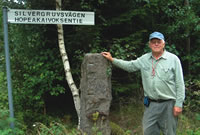 The history of mining in Finland dates back to the mid-16th century, more than 300 years before Canada’s birth as a nation. Now, it’s Canadian expertise that’s spearheading a renaissance of mining in the Scandinavian country.
The history of mining in Finland dates back to the mid-16th century, more than 300 years before Canada’s birth as a nation. Now, it’s Canadian expertise that’s spearheading a renaissance of mining in the Scandinavian country.
Bill Karvinen, a former resident geologist in Sudbury and Timmins, teamed up with fellow geologist Alf Bjorklund of Finland in 2005 to aggressively pursue long forgotten base metal opportunities in the country. Their private, Finnish-based company, Magnus Minerals Oy, boasts landholdings of approximately 2,500 square kilometres encompassing more than 100 base metal properties.
Several factors contributed to the decline of mining in Finland over the years, including legislation in force until 1994 that barred foreigners from mineral exploration and limited foreign ownership of mineral resources. Then state-owned Outokumpu decided to get out of the mining business and left a void, said Karvinen in an interview at Magnus Minerals’ Sudbury office.
“Finland didn’t have a junior market the way we do here.”
Karvinen, of Finnish extraction, was born and raised in Sudbury and earned a PhD in Geology from Queen’s University in Kingston, Ontario. After brief stints with the Geological Survey of Canada and the Ontario Geological Survey, he opted for a career in consulting.
An old-timer who graduated when electric typewriters were considered high tech, Karvinen is, nonetheless, a big believer in applying cutting-edge computer technology to mineral exploration.
With the help of his son, Erik, an urban planner with expertise in geographic information systems (GIS), Karvinen is compiling an extensive GIS-referenced database of geophysical, geochemical and assay data to evaluate and interpret potential mineral deposits on Magnus’s extensive landholdings.
The use of GIS software in mineral exploration is beginning to catch on, but it’s nowhere near as prevalent as in urban planning and other disciplines, said Erik.
Digital divide
Too often, complains Bill, “you have the techies sitting in one corner who know nothing about geology and the geologists sitting in another corner, so there’s this digital divide.”
Using GIS, “you can combine layers, separate them, turn them on or off, look at geospatial relationships and do queries.”
It’s the only effective way to manage the explosion of data that is available to geologists today, he said.
According to Karvinen, GIS technology is largely responsible for the evolution of geology as a science.
“You can’t say that geology has been much of a science until now and the reason is that it has been very dependent on peoples’ biases,” he said. “A science is only a science if it’s reproducible. If two, three or five geologists looked at a core, the chances are that you’re going to have an equal number of opinions about what it is. That’s not reproducibility.
“With GIS, it doesn’t matter how many times you plot things in space. It’s always going to plot the same way. That’s when geology begins to be a science.”
GIS, according to Karvinen, liberates the discipline from the biases of geologists who pass judgment on potential exploration targets without all the facts, including “people who say, ‘There’s no nickel in Labrador. Why would you ever look for nickel in Labrador?’
“If we’re going to find more ore deposits, there will have to be a paradigm shift. We are going to have to start looking at the facts and separating them from the biases.”
The challenge facing the mineral exploration industry was starkly highlighted at the recent Exploration07 conference in Toronto, said Karvinen.
“The cost to find a new mine has gone up and the number of mines discovered has gone down. The graph is very explicit. Why is it? We have powerful geophysical equipment that can generate zillions of points of data. We can look deeper, look everywhere, look faster, do everything and analyze to a minute degree the differences in chemical composition of everything. It’s all there and, yet, we haven’t been able to find more mines. I think there are two problems. We don’t prospect the data available and we don’t prospect anymore in the field because it’s not sexy.”
Practicing what he preaches, Karvinen is making extensive use of data mining and fieldwork to identify prospective targets and partner with exploration companies interested in playing a role in the renaissance of Finland’s mining industry.
In May, Magnus entered into a joint venture with FinMetal Mining Ltd. on its Enonkoski Nickel Belt properties, including the former producing Halvala Nickel Mine. The deal allows FinMetal to earn a 51 per cent interest in the project in return for 3 million Euros in option payments and a commitment to spend $10 million on exploration activity.
Karvinen and his partners are also managing an exploration program at their zinc-lead-silver-copper Attu project, one of three properties folded into a separate company, Attu Zinc Ltd.
The resurgence of mining in Finland has other Canadian connections. Toronto-based Inmet Mining Corporation, for example, is operating the Pyhasalmi copper-zinc mine, and Agnico Eagle is developing the Kittila Mine, a gold property in Finnish Lapland, 900 kilometres north of Helsinki.
Magnus is an ideal partner for other Canadian companies interested in Finland, said Erik.
“It’s not easy for a foreigner to work there. The language is a problem and things are done differently. If you have local connections, it makes it that much easier to do business there.”
www.magnusminerals.com
www.attuzinc.com


.jpg;w=120;h=80;mode=crop)